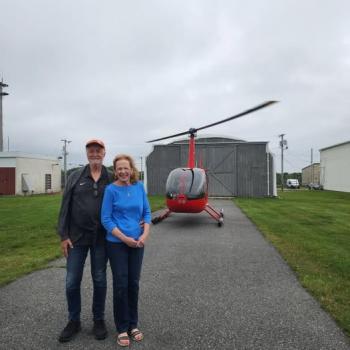Annie Dillard once wrote that if we truly paid attention to what we were doing, we would wear hard hats to church rather than fancy clothes. Or perhaps at least during the Sanctus when we celebrate the “Holy Lord, God of power and might.” Each of us is “something under construction”—real tools are in order.
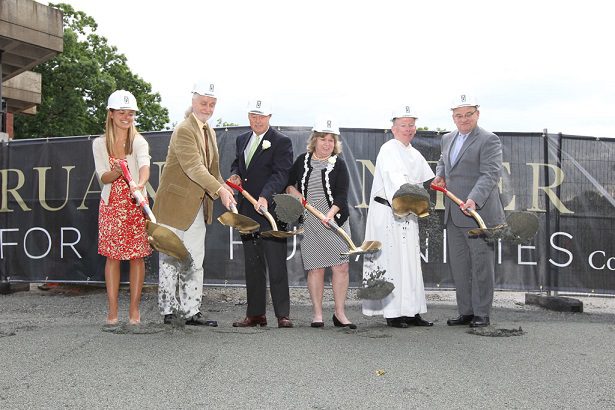
I love August on campus, a month in which things are relatively quiet in anticipation of students returning for the fall semester. As I walked on campus last Saturday, though, I passed three major areas of construction–a large extension to the athletic complex, a long awaited addition to and update of the science buildings, and significant landscaping as the remainder of a street that used to bisect campus is removed. I have taught at the college for more than twenty years and have seen many changes, but the last decade has been virtually non-stop construction. All things keep becoming new.
A few years ago, someone from the College Events office contacted me, wondering whether I would be willing to speak on behalf of the faculty at the groundbreaking ceremony for the new humanities building that was to be built over the following eighteen months.
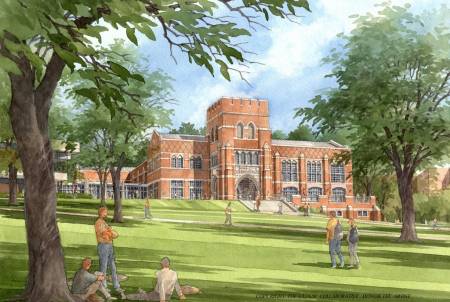
Since at the time I was the director of the large program that would be housed in this new building, and had been part of the design and planning committee for the previous year, the request made sense. I spent the next week and a half thinking about what I would like to say, then shaping it to fit into the rather tight four-minute slot reserved on the program for my insights.
What I did not anticipate was that as one of four speakers at the ceremony, I would be doing more than just speaking. I would also be one of the six persons ceremonially “breaking ground.” The 150 or so attendees were forced by a driving rainstorm inside the library for the speaking portion of the event, but the rain mercifully stopped long enough afterward for everyone to step back outside. In front of the security fence surrounding the construction site was a mound of dirt; stuck in the mound in a neat row were six small shovels painted gold—in size roughly half-way between a kid’s sand shovel and a working shovel—topped by six white hard hats, of the sort that one might buy at Toys ‘R’ Us. A shovel and a hat for the college President, the Provost, an honors junior representing the student body, the several million dollar lead donor, his wife, and me. Orchestrated by the main photographer, the six of us were photographed several times each with our hands on the shovel, picking up a tiny bit of dirt, and throwing it gently in front of us, all the time wearing hard hats that could not have protected us from a falling twig from the overhead elm.
It has struck me frequently since what a strange and peculiar ceremony this was—the official start of construction on a $20 million dollar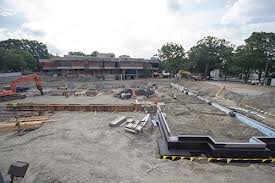 , 63,000 square foot building that would take a year and a half to assemble was marked by several people wearing fancy clothes pretending to work, equipped with fake and completely useless work tools. The actual construction work began the next day as a barrier wall and small utility building were demolished, numerous backhoes arrived, and real workers wearing real hard hats and wielding real shovels started in earnest. At the dedication ceremony when the building was finished, we should have marked the event by asking six construction workers to don academic robes and submit to a few photo ops while pretending to be professors.
, 63,000 square foot building that would take a year and a half to assemble was marked by several people wearing fancy clothes pretending to work, equipped with fake and completely useless work tools. The actual construction work began the next day as a barrier wall and small utility building were demolished, numerous backhoes arrived, and real workers wearing real hard hats and wielding real shovels started in earnest. At the dedication ceremony when the building was finished, we should have marked the event by asking six construction workers to don academic robes and submit to a few photo ops while pretending to be professors.
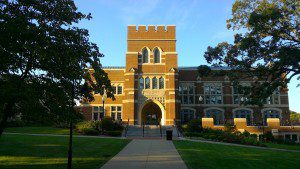
Of course, no one thought that any real construction work was going on at the groundbreaking ceremony—it’s just a tradition that has developed to mark the beginning of a long, expensive, loud and messy process. I think it might be good to think of church attendance as having the same relationship to the life of spiritual commitment as a groundbreaking ceremony has to the construction of a building. In church we are going through various ceremonial reminders—liturgy, scripture, Eucharist—of important elements of the life of faith. But these ceremonial reminders are no more a replacement for real spiritual work than digging up a few clumps of dirt with a toy shovel is a replacement for the heavy lifting of actual construction.
My lengthy list of novels to read this summer included The Hummingbird’s Daughter by Luis Alberto Urrea. It is an end-of-the-nineteenth-century story of a woman who came to be considered by many people in Mexico as a saint, a miracle worker and a healer. Half Indian and half Spanish, abandoned by her mother and abused by her aunt who is raising her, Teresita is recognized as possessing special gifts by Huila, a midwife/healer/miracle worker in her own right. Huila welcomes Teresita into her home and becomes her mentor. In the midst of a lesson about the sacramental nature of all things, Huila tells Teresita of a fascinating legend.
“The Virgin came to your people,” Huila said.
“My people?”
“Oh yes. The Mayos saw la Virgencita before the priests came.”
Teresita stopped and stared up at her teacher in the dark.
“What happened?”
Huila puffed her pipe. It was good. It was very, very good.
“It was before. Before you, and before me.”
Teresita was astonished by this revelation: there had been a time before Huila.
“The Mother of God appeared to a group of warriors who were out in the desert, hunting. And they looked up, and there she was, descending from the sky. She was, I imagine, all in purple. The Mother of God likes purple. So she came down to them from heaven, and they were stunned and shaking with fear.”
“What did they do?”
“They ran away and hid behind bushes.”
“What did she do?”
“Well, she had an accident.”
“What happened?”
“She landed on top of a cactus.”
“Oh no!”
“Oh yes. The Mother of God was stuck on top of a huge cactus, and the warriors started throwing rocks at her and shooting arrows at her, but they could not hit her. You see, they had never seen a Yori before, and they had never seen a flying Yori, or a magnificent creature like her! So they tried to kill her.”
Teresita put her hands over her face.
“And then what?” she cried.
“Then the Mother of God spoke to the warriors from atop her cactus.”
“What did she say? What did she say?”
“She said—‘Get me a ladder!’”
“What!”
“Get me a ladder, that’s what she said. It’s true. Holy be her name.”
Both burst out laughing.
“What did they do?”
“I imagine they fetched her a ladder! You see, this is how Heaven works, They’re practical. We are always looking for rays of light. For lightning bolts or burning bushes. But God is a worker, like us. He made the world—He didn’t hire anyone to build it for him! God has worker’s hands. Just remember—angels carry no harps. Angels carry hammers.”







